Challenges and Solutions of Hydrogen Fuel Cells in Transportation Systems: A Review and Prospects
Abstract
1. Introduction
2. Motorcycles, Scooters, and Bicycles
3. Passenger Cars
Hydrogen Storage System in Passenger Cars
4. Buses
Hydrogen Storage System in Passenger Cars
5. Trains
6. Trucks
- Side-rail tanks: This is the most convenient model, as most MD and HD trucks already have this space available.
- Back-of-cab storage: This is an option for larger trucks, typically classes 4 to 8.
- Under the chassis: This is suitable for smaller-class vehicles (e.g., class 3 and below). This configuration can only work for particular trucks because of chassis design constraints, i.e., the tanks do not interfere with the beams.
- On top of vehicle: This type can only be used on certain trucks and results in a higher center of gravity.
7. Aerial Transportation Systems
7.1. Fuel Cells for Non-Propulsive Applications (Electric Power Generation)
| Parameter | PEMFC | SOFC |
|---|---|---|
| Electrolyte | Proton exchange membranes | Ceramic |
| Operating temp. | 80–100 °C | 600–1000 °C |
| Charge carrier | H+ | O2− |
| Reforming process for HC fuels | External | Partial external pre-reforming, partial stack-internal |
| Prime cell components | Carbon-based | Ceramic based |
| Catalyst | Platinum | Perovskites/nickel |
| Robustness against poisoning | Highly sensitive to CO, UHC, S | Sensitive to S |
| Product H2O management | Evaporative | Gaseous product |
| Product heat management | Process gas + independent cooling medium | Internal reforming + process gas |
| H2O effluent location | Air side | Fuel side |
| System efficiency | >40% | >75% (hybrid SOFC) |
| Response to load change | Quick, dynamic system behavior | Slow, static system behavior |
| Maturity | First operational test series in automotive industry | Breadboard units for mobile application |
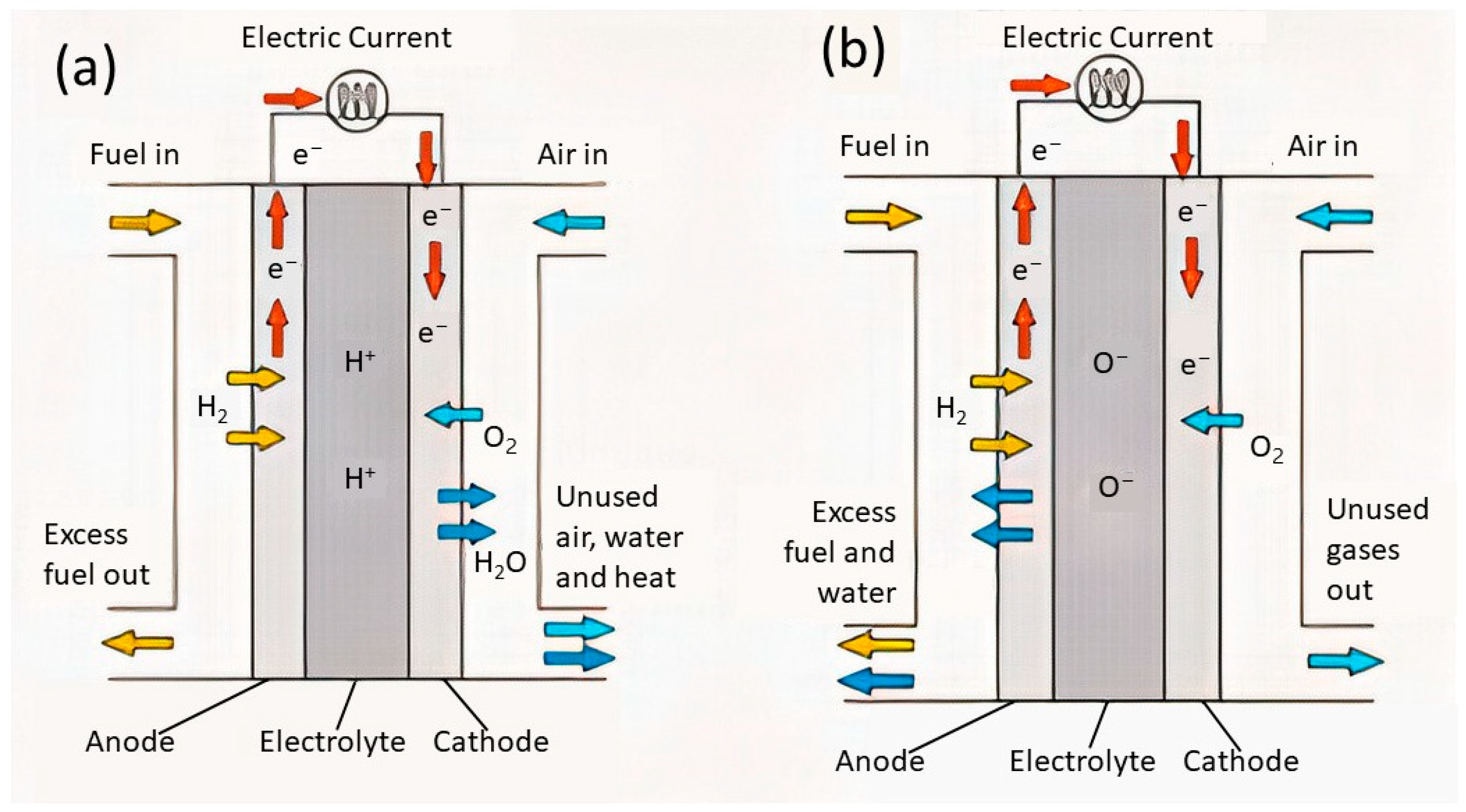
7.2. Fuel Cells for Propulsive Applications
8. Conclusions
Author Contributions
Funding
Data Availability Statement
Conflicts of Interest
References
- Cook, B. Introduction to fuel cells and hydrogen technology. Eng. Sci. Educ. J. 2002, 11, 205–216. [Google Scholar] [CrossRef]
- Ananthachar, V.; Duffy, J.J. Efficiencies of hydrogen storage systems onboard fuel cell vehicles. Sol. Energy 2005, 78, 687–694. [Google Scholar] [CrossRef]
- Bairabathina, S.; Balamurugan, S. Review on non-isolated multi-input step-up converters for grid-independent hybrid electric vehicles. Int. J. Hydrogen Energy 2020, 45, 21687–21713. [Google Scholar] [CrossRef]
- Briguglio, N.; Andaloro, L.; Ferraro, M.; Antonucci, V. Fuel Cell Hybrid Electric Vehicles. In Electric Vehicles, The Benefits and Barriers; InTech: London, UK, 2011. [Google Scholar]
- Horrell, P. Hyundai Motor Group Tech 2019. The Future Lies in: EV? or FCEV? 2019. Available online: https://fuelcellsworks.com/news/the-future-lies-in-ev-or-fcev/#disqus_thread (accessed on 29 May 2023).
- Thomas, C.E. Fuel cell and battery electric vehicles compared. Int. J. Hydrogen Energy 2009, 34, 6005–6020. [Google Scholar] [CrossRef]
- Valdés-lópez, V.F.; Mason, T.; Shearing, P.R.; Brett, D.J.L. Carbon monoxide poisoning and mitigation strategies for polymer electrolyte membrane fuel cells—A review. Prog. Energy Combust. Sci. 2020, 79, 100842. [Google Scholar] [CrossRef]
- Wang, F.; Kishimoto, H.; Ishiyama, T.; Develos-Bagarinao, K.; Yamaji, K.; Horita, T.; Yokokawa, H. A review of sulfur poisoning of solid oxide fuel cell cathode materials for solid oxide fuel cells. J. Power Sources 2020, 478, 228763. [Google Scholar] [CrossRef]
- Franceschini, E.A.; Levitan, D.; Rodriguez, C.R.; Mu, P.; Humana, T.; Correa, G. Comparative analysis of cost, emissions and fuel consumption of diesel, natural gas, electric and hydrogen urban buses. Energy Convers. Manag. 2022, 257, 115412. [Google Scholar] [CrossRef]
- Yılmaz, M.; Özdemir, S. Review of Motors used in Commercial Electric Vehicles. In Proceedings of the 5th International Mediterranean Science and Engineering Congress (IMSEC 2020), Antalya, Turkey, 21–23 October 2021. [Google Scholar]
- Wang, H.; Gaillard, A.; Hissel, D. A review of DC/DC converter-based electrochemical impedance spectroscopy for fuel cell electric vehicles. Renew. Energy 2019, 141, 124–138. [Google Scholar] [CrossRef]
- Staffell, I.; Scamman, D.; Velazquez Abad, A.; Balcombe, P.; Dodds, P.E.; Ekins, P.; Shah, N.; Ward, K.R. The role of hydrogen and fuel cells in the global energy system. Energy Environ. Sci. 2019, 12, 463–491. [Google Scholar] [CrossRef]
- Weigl, J.; Inayati, I.; Zind, E.; Said, H. Pios fuel cell motorcycle; design, development and test of hydrogen fuel cell powered vehicle. In Proceedings of the 2008 IEEE International Conference on Sustainable Energy Technologies, Singapore, 24–27 November 2008; pp. 1120–1122. [Google Scholar] [CrossRef]
- Weigl, J.D.; Henz, M.; Inayati; Saidi, H. Converted battery-powered electric motorcycle and hydrogen fuel cell-powered electric motorcycle in South East Asia: Development and performance test. In Proceedings of the Joint International Conference on Electric Vehicular Technology and Industrial, Mechanical, Electrical and Chemical Engineering (ICEVT 2015 & IMECE 2015), Surakarta, Indonesia, 4–5 November 2015; pp. 1–4. [Google Scholar] [CrossRef]
- Weigl, J.D.; Inayati, I.; Saidi, H. Development of Hydrogen Fuel Cell Motorcycle in South East Asia. ECS Trans. 2011, 30, 289–293. [Google Scholar] [CrossRef]
- Hwang, J.J. Review on development and demonstration of hydrogen fuel cell scooters. Renew. Sustain. Energy Rev. 2012, 16, 3803–3815. [Google Scholar] [CrossRef]
- Hwang, J.J.; Chang, W.R. Life-cycle analysis of greenhouse gas emission and energy efficiency of hydrogen fuel cell scooters. Int. J. Hydrogen Energy 2010, 35, 11947–11956. [Google Scholar] [CrossRef]
- Cox, B.L.; Mutel, C.L. The environmental and cost performance of current and future motorcycles. Appl. Energy 2018, 212, 1013–1024. [Google Scholar] [CrossRef]
- Chen, H.S.; Tsai, B.K.; Hsieh, C.M. Determinants of consumers’ purchasing intentions for the hydrogen-electric motorcycle. Sustainability 2017, 9, 1447. [Google Scholar] [CrossRef]
- Mellino, S.; Petrillo, A.; Cigolotti, V.; Autorino, C.; Jannelli, E.; Ulgiati, S. A Life Cycle Assessment of lithium battery and hydrogen-FC powered electric bicycles: Searching for cleaner solutions to urban mobility. Int. J. Hydrogen Energy 2017, 42, 1830–1840. [Google Scholar] [CrossRef]
- Kheirandish, A.; Kazemi, M.S.; Dahari, M. Dynamic performance assessment of the efficiency of fuel cell-powered bicycle: An experimental approach. Int. J. Hydrogen Energy 2014, 39, 13276–13284. [Google Scholar] [CrossRef]
- Bartolozzi, I.; Rizzi, F.; Frey, M. Comparison between hydrogen and electric vehicles by life cycle assessment: A case study in Tuscany, Italy. Appl. Energy 2013, 101, 103–111. [Google Scholar] [CrossRef]
- The Future of Hydrogen; International Energy Agency: Paris, France, 2019. [CrossRef]
- Samsun, R.C.; Antoni, L.; Rex, M.; Stolten, D. Deployment Status of Fuel Cells in Road Transport: 2021 Update; Forschungszentrum Jülich GmbH Zentralbibliothek: Jülich, Germany, 2021; Volume 542. [Google Scholar]
- Statista. Global Transport CO2 Emissions Breakdown 2020. Available online: https://www.statista.com/statistics/1185535/transport-carbon-dioxide-emissions-breakdown/ (accessed on 27 February 2023).
- IEA. Electric and Plug-In Hybrid Vehicle Roadmap; IEA: Paris, France, 2010; p. 4. [Google Scholar]
- What’s Next for Batteries in 2023. MIT Technology Review. Available online: https://www.technologyreview.com/2023/01/04/1066141/whats-next-for-batteries/ (accessed on 28 February 2023).
- Fuel Cell Market Growth Drivers and Opportunities. Size, Share. Available online: https://www.marketsandmarkets.com/Market-Reports/fuel-cell-market-348.html?gclid=EAIaIQobChMI7rnL47q3_QIVUwGLCh37kwc1EAAYASAAEgKwEfD_BwE (accessed on 28 February 2023).
- Abdelkareem, M.A.; Sayed, E.T.; Alawadhi, H.; Alami, A.H. Synthesis and testing of cobalt leaf-like nanomaterials as an active catalyst for ethanol oxidation. Int. J. Hydrogen Energy 2020, 45, 17311–17319. [Google Scholar] [CrossRef]
- Dell, R.M.; Moseley, P.T.; Rand, D.A.J. Towards Sustainable Road Transport; Elsevier: Amsterdam, The Netherlands, 2014. [Google Scholar] [CrossRef]
- Gurz, M.; Baltacioglu, E.; Hames, Y.; Kaya, K. The meeting of hydrogen and automotive: A review. Int. J. Hydrogen Energy 2017, 42, 23334–23346. [Google Scholar] [CrossRef]
- Ehsani, M.; Gao, Y.; Longo, S.; Ebrahimi, K. Modern Electric, Hybrid Electric, and Fuel Cell Vehicles, 3rd ed.; CRC Press: Boca Raton, FL, USA, 2018. [Google Scholar] [CrossRef]
- Panik, F. Fuel cells for vehicle applications in cars—Bringing the future closer. J. Power Sources 1998, 71, 36–38. [Google Scholar] [CrossRef]
- Wilberforce, T.; El-Hassan, Z.; Khatib, F.N.; Al Makky, A.; Baroutaji, A.; Carton, J.G.; Olabi, A.G. Developments of electric cars and fuel cell hydrogen electric cars. Int. J. Hydrogen Energy 2017, 42, 25695–25734. [Google Scholar] [CrossRef]
- Moriya, T. Transportation and Safety in Japan. IATSS Res. 2002, 26, 119. [Google Scholar]
- Matsunaga, M.; Fukushima, T.; Ojima, K. Powertrain system of honda FCX clarity fuel cell Vehicle. World Electr. Veh. J. 2009, 3, 820–829. [Google Scholar] [CrossRef]
- Hong, B.K.; Kim, S.H. (Invited) Recent Advances in Fuel Cell Electric Vehicle Technologies of Hyundai. ECS Meet. Abstr. 2018, MA2018-02, 1630. [Google Scholar] [CrossRef]
- Lohse-Busch, H.; Stutenberg, K.; Duoba, M.; Liu, X.; Elgowainy, A.; Wang, M.; Wallner, T.; Richard, B.; Christenson, M. Automotive fuel cell stack and system efficiency and fuel consumption based on vehicle testing on a chassis dynamometer at minus 18 °C to positive 35 °C temperatures. Int. J. Hydrogen Energy 2020, 45, 861–872. [Google Scholar] [CrossRef]
- Philip, N.; Ghosh, P.C. A generic sizing methodology for thermal management system in fuel cell vehicles using pinch analysis. Energy Convers. Manag. 2022, 269, 116172. [Google Scholar] [CrossRef]
- Berry, G.D.; Pasternak, A.D.; Rambach, G.D.; Smith, J.R.; Schock, R.N. Hydrogen as a future transportation fuel. Energy 1996, 21, 289–303. [Google Scholar] [CrossRef]
- Smith, J.R.; Aceves, S.M.; Johnson, N.L.; Amsden, A.A. Progress toward an optimized hydrogen series hybrid engine. In Proceedings of the 95. American Society of Mechanical Engineers` (ASME) Internal Combustion Engin Fall Conference, Milwaukee, WI, USA, 24–27 September 1995. [Google Scholar] [CrossRef]
- Sakintuna, B.; Lamari-Darkrim, F.; Hirscher, M. Metal hydride materials for solid hydrogen storage: A review. Int. J. Hydrogen Energy 2007, 32, 1121–1140. [Google Scholar] [CrossRef]
- Chalk, S.G.; Miller, J.F.; Wagner, F.W. Challenges for fuel cells in transport applications. J. Power Sources 2000, 86, 40–51. [Google Scholar] [CrossRef]
- Zaetta, R.; Madden, B. Hydrogen Fuel Cell Bus Technology State of the Art Review, 2013; No. 245133.
- Eudy, L.; Post, M.; Jeffers, M.; Eudy, L.; Post, M.; Jeffers, M. Zero Emission Bay Area (ZEBA) Fuel Cell Bus Demonstration Results: Sixth Report; National Renewable Energy Laboratory: Golden, CO, USA, 2017.
- Folkesson, A.; Andersson, C.; Alvfors, P.; Alaküla, M.; Overgaard, L. Real life testing of a Hybrid PEM Fuel Cell Bus. J. Power Sources 2003, 118, 349–357. [Google Scholar] [CrossRef]
- Bubna, P.; Brunner, D.; Gangloff, J.J.; Advani, S.G.; Prasad, A.K. Analysis, operation and maintenance of a fuel cell/battery series-hybrid bus for urban transit applications. J. Power Sources 2010, 195, 3939–3949. [Google Scholar] [CrossRef]
- Zamora, I.; San Martín, J.I.; García, J.; Asensio, F.J.; Oñederra, O.; San Martín, J.J.; Aperribay, V. PEM fuel cells in applications of urban public transport. Renew. Energy Power Qual. J. 2011, 1, 599–604. [Google Scholar] [CrossRef]
- Byung, K.A.; Tae, W.L. Fuel cell vehicle development at Hyundai-Kia motors. In Proceedings of the 2006 International Forum on Strategic Technology, Ulsan, Republic of Korea, 18–20 October 2006; pp. 199–201. [Google Scholar] [CrossRef]
- Saxe, M.; Folkesson, A.; Alvfors, P. Energy system analysis of the fuel cell buses operated in the project: Clean Urban Transport for Europe. Energy 2008, 33, 689–711. [Google Scholar] [CrossRef]
- Li, J.; Hu, Z.; Xu, L.; Ouyang, M.; Fang, C.; Hu, J.; Cheng, S.; Po, H.; Zhang, W.; Jiang, H. Fuel cell system degradation analysis of a Chinese plug-in hybrid fuel cell city bus. Int. J. Hydrogen Energy 2016, 41, 15295–15310. [Google Scholar] [CrossRef]
- Basu, S. Proton exchange membrane fuel cell technology: India’s perspective. Proc. Indian Natl. Sci. Acad. 2015, 81, 865–890. [Google Scholar] [CrossRef]
- Hua, T.; Ahluwalia, R.; Eudy, L.; Singer, G.; Jermer, B.; Asselin-Miller, N.; Wessel, S.; Patterson, T.; Marcinkoski, J. Status of hydrogen fuel cell electric buses worldwide. J. Power Sources 2014, 269, 975–993. [Google Scholar] [CrossRef]
- World’s First Fuel Cell Tram for Foshan, China: World’s First Commercial Fuel Cell Powered Tram Line; Ballard: Burnaby, BC, Canada, 2021.
- UIC. Railway Handbook 2017: Energy Consumption and CO2 Emissions; International Energy Agency (IEA) and International Union of Railways (UIC): Paris, France, 2017. [Google Scholar]
- Hsiao, D.R.; Huang, B.W.; Shih, N.C. Development and dynamic characteristics of hybrid fuel cell-powered mini-train system. Int. J. Hydrogen Energy 2012, 37, 1058–1066. [Google Scholar] [CrossRef]
- US EPA. EPA Air Emissions Inventories. 2015. Available online: https://www.epa.gov/air-emissions-inventories (accessed on 3 February 2023).
- U.S. Energy Information Administration. Annual Energy Outlook 2016; U.S. Energy Information Administration: Washington, DC, USA, 2016.
- U.S. Energy Information Administration. Annual Energy Outlook 2015 with Projections to 2040; U.S. Energy Information Administration: Washington, DC, USA, 2015.
- Vision for Clean Air: A Framework for Air Quality and Climate Planning. 2012. Available online: https://www.aqmd.gov/docs/default-source/clean-air-plans/air-quality-management-plans/2012-air-quality-management-plan/vision-for-clean-air-2012/draft-vision-for-clean-air-a-framework-for-air-quality-and-climate-planning.pdf?sfvrsn=4 (accessed on 3 February 2023).
- Williams, J.H.; Haley, B.; Kahrl, F.; Moore, J.; Jones, A.D.; Torn, M.S.; McJeon., H. Pathways to Deep Decarbonization in the United States. 2014. Available online: https://ethree.com/publications/index_US2050.php (accessed on 3 February 2023).
- Kast, J.; Morrison, G.; Gangloff, J.J.; Vijayagopal, R.; Marcinkoski, J. Designing hydrogen fuel cell electric trucks in a diverse medium and heavy duty market. Res. Transp. Econ. 2018, 70, 139–147. [Google Scholar] [CrossRef]
- Davis, S.C.; Diegel, S.W.; Boundy, R.G. Transportation Energy Futures; the Oak Ridge National Laboratory Oak Ridge: Oak Ridge, TN, USA, 2015; p. 37831-6073. Available online: https://tedb.ornl.gov/ (accessed on 13 February 2023).
- H2-Share Project Home Trucks News & Events Documents about Stakeholders Contact in Operation Planned Concept. 2023. Available online: https://fuelcelltrucks.eu/project/ (accessed on 13 February 2023).
- Kast, J.; Vijayagopal, R.; Gangloff, J.J.; Marcinkoski, J. Clean commercial transportation: Medium and heavy duty fuel cell electric trucks. Int. J. Hydrogen Energy 2017, 42, 4508–4517. [Google Scholar] [CrossRef]
- Çabukoglu, E.; Georges, G.; Küng, L.; Pareschi, G.; Boulouchos, K. Fuel cell electric vehicles: An option to decarbonize heavy-duty transport? Results from a Swiss case-study. Transp. Res. Part D Transp. Environ. 2019, 70, 35–48. [Google Scholar] [CrossRef]
- Lewis, M.; Hearn, C.; Feng, X.; Hanlin, J.; Levin, J.; Ambrosio, J.; Guggenheim, P.; Walker, C. Design and modeling for hydrogen fuel cell conversion of parcel delivery trucks. In Proceedings of the 2017 IEEE Transportation Electrification Conference and Expo (ITEC), Chicago, IL, USA, 22–24 June 2017; pp. 674–678. [Google Scholar] [CrossRef]
- Cunanan, C.; Tran, M.K.; Lee, Y.; Kwok, S.; Leung, V.; Fowler, M. A Review of Heavy-Duty Vehicle Powertrain Technologies: Diesel Engine Vehicles, Battery Electric Vehicles, and Hydrogen Fuel Cell Electric Vehicles. Clean Technol. 2021, 3, 474–489. [Google Scholar] [CrossRef]
- Carbon Market Watch. Climate Action Network and International Coalition for Sustainable Aviation Joint Input to the Talanoa Dialogue. Available online: https://carbonmarketwatch.org/publications/climate-action-network-and-international-coalition-for-sustainable-aviation-joint-input-to-the-talanoa-dialogue/ (accessed on 7 October 2022).
- ICAO Environmental. Trends in Emissions That Affect Climate Change. Available online: https://www.icao.int/environmental-protection/Pages/ClimateChange_Trends.aspx (accessed on 8 October 2022).
- European Commission. Reducing Emissions from Aviation. Available online: https://climate.ec.europa.eu/eu-action/transport-emissions/reducing-emissions-aviation_en (accessed on 8 October 2022).
- Hydrogen-Powered Aviation; Publications Office: Luxembourg, 2020. [CrossRef]
- Federal Aviation Administration (FAA). SPORT PILOT & AIRCRAFT Affo Fun g Flyin. 2008. Available online: www.AIR-PROS.com (accessed on 29 October 2022).
- Federal Aviation Administration. Small Airplanes. Available online: https://www.faa.gov/aircraft/air_cert/design_approvals/small_airplanes/categories (accessed on 29 October 2022).
- IATA Air Transport & Travel Industry. XML Implementation Guide; International Air Transport Association: Montreal, QC, Canada, 2010. [Google Scholar]
- Collins, J.M.; McLarty, D. All-electric commercial aviation with solid oxide fuel cell-gas turbine-battery hybrids. Appl. Energy 2020, 265, 114787. [Google Scholar] [CrossRef]
- Misra, A. Energy storage for electrified aircraft: The need for better batteries, fuel cells, and supercapacitors. IEEE Electrif. Mag. 2018, 6, 54–61. [Google Scholar] [CrossRef]
- BBC Archive. The Brits Who Bolstered the Moon landings. Available online: https://www.bbc.co.uk/archive/the-brits-who-bolstered-the-moon-landings/zfcrscw (accessed on 30 September 2022).
- NASA. Space Applications of Hydrogen and Fuel Cells. 2015. Available online: http://www.nasa.gov/content/space-applications-of-hydrogen-and-fuel-cells (accessed on 9 October 2022).
- Baroutaji, A.; Wilberforce, T.; Ramadan, M.; Olabi, A.G. Comprehensive investigation on hydrogen and fuel cell technology in the aviation and aerospace sectors. Renew. Sustain. Energy Rev. 2019, 106, 31–40. [Google Scholar] [CrossRef]
- Masiol, M.; Harrison, R.M. Aircraft engine exhaust emissions and other airport-related contributions to ambient air pollution: A review. Atmos. Environ. 2014, 95, 409–455. [Google Scholar] [CrossRef] [PubMed]
- Handbook for Evaluating Emissions and Costs of APUs and Alternative Systems; Airport Cooperative Research Program; Transportation Research Board: Washington, DC, USA, 2012.
- Braun, R.J.; Gummalla, M.; Yamanis, J. System architectures for solid oxide fuel cell-based auxiliary power units in future commercial aircraft applications. J. Fuel Cell Sci. Technol. 2009, 6, 0310151–03101510. [Google Scholar] [CrossRef]
- Chinda, P.; Brault, P. The hybrid solid oxide fuel cell (SOFC) and gas turbine (GT) systems steady state modeling. Int. J. Hydrogen Energy 2012, 37, 9237–9248. [Google Scholar] [CrossRef]
- Rajashekara, K.; Grieve, J.; Daggett, D. A feasibility study for onboard power generation using a combination of solid oxide fuel cells and gas turbines. IEEE Ind. Appl. Mag. 2008, 14, 54–60. [Google Scholar] [CrossRef]
- Daggett, D. Product Development, Boeing Fuel Cell APU Overview. In Proceedings of the SECA Annual Meeting, Seattle, WA, USA, 15 April 2003. [Google Scholar]
- Barelli, L.; Bidini, G.; Ottaviano, A. Part load operation of a SOFC/GT hybrid system: Dynamic analysis. Appl. Energy 2013, 110, 173–189. [Google Scholar] [CrossRef]
- Dollmayer, J.; Bundschuh, N.; Carl, U.B. Fuel mass penalty due to generators and fuel cells as energy source of the all-electric aircraft. Aerosp. Sci. Technol. 2006, 10, 686–694. [Google Scholar] [CrossRef]
- Spencer, K.M.; Martin, C.A. Investigation of Potential Fuel Cell Use in Aircraft; Institute for Defense Analyses: Alexandria, VA, USA, 2013. [Google Scholar]
- Eelman, S.; Poza, I.D.P.D.; Krieg, T. Fuel Cell Apu’s in Commercial Aircraft—An Assessment of Sofc and Pemfc Concepts. In Proceedings of the 24th International Congress of the Aeronautical Sciences, Yokohama, Japan, 29 August–3 September 2004. [Google Scholar]
- Baharozu, E.; Soykan, G.; Baris Ozerdem, M. Future aircraft concept in terms of energy efficiency and environmental factors. Energy 2017, 140, 1368–1377. [Google Scholar] [CrossRef]
- Wu, S.; Li, Y. Fuel cell applications on more electrical aircraft. In Proceedings of the 2014 17th International Conference on Electrical Machines and Systems (ICEMS), Hangzhou, China, 22–25 October 2014; pp. 198–201. [Google Scholar] [CrossRef]
- Wikipedia. Fuel Cell. 2021. Available online: https://en.wikipedia.org/wiki/Fuel_cell (accessed on 29 October 2022).
- Whyatt, G.A.; Chick, L.A. Electrical Generation for More-Electric Aircraft Using Solid Oxide Fuel Cells; U.S. Department of Energy: Washington, DC, USA, 2012; 110p.
- Daggett, D. Fuel Cells & Hydrogen Airplanes. In Proceedings of the Canada and US Fuel Cell & Hydrogen Partner Meeting, Seattle, WA, USA, 14–17 July 2003. [Google Scholar]
- Gummalla, M.; Pandy, A.; Braun, R.; Carriere, T.; Yamanis, J.; Vanderspurt, T.; Hardin, L.; Welch, R. Fuel Cell Airframe Integration Study for Short-Range Aircraft; NASA/CR—2006-214457/VOL1; NASA: Hanover, MD, USA, 2006.
- Sehra, A.K.; Whitlow, W. Propulsion and power for 21st century aviation. Prog. Aerosp. Sci. 2004, 40, 199–235. [Google Scholar] [CrossRef]
- Freeh, J.E.; Steffen, C.J.; Larosiliere, L.M. Off-Design Performance Analysis of a Solid-Oxide Fuel Cell/Gas Turbine Hybrid for Auxiliary Aerospace Power. In Proceedings of the ASME 2005 3rd International Conference on Fuel Cell Science, Engineering and Technology, Ypsilanti, MI, USA, 23–25 May 2005; pp. 265–272. [Google Scholar] [CrossRef]
- Winkler, W.G.; Nehter, P.; Winkler, W.; Nehter, P.; Winkler, W. System analysis of Fuel Cell APUs for Aircraft applications. In Proceedings of the Workshop 1—Aerospace Applications, Hamburg, Germany, 31 August–1 September 2005; pp. 1–16. [Google Scholar]
- Bertran, E.; Sanchez-Cerda, A. On the Tradeoff between Electrical Power Consumption and Flight Performance in Fixed-Wing UAV Autopilots. IEEE Trans. Veh. Technol. 2016, 65, 8832–8840. [Google Scholar] [CrossRef]
- Suewatanakul, S.; Porcarelli, A.; Olsson, A.; Grimler, H.; Chiche, A.; Mariani, R.; Lindbergh, G. Conceptual Design of a Hybrid Hydrogen Fuel Cell/Battery Blended-Wing-Body Unmanned Aerial Vehicle—An Overview. Aerospace 2022, 9, 275. [Google Scholar] [CrossRef]
- Farajollahi, A.H.; Rostami, M.; Marefati, M. A hybrid-electric propulsion system for an unmanned aerial vehicle based on proton exchange membrane fuel cell, battery, and electric motor. Energy Sources Part A Recover. Util. Environ. Eff. 2022, 44, 934–950. [Google Scholar] [CrossRef]
- Wang, B.; Zhao, D.; Li, W.; Wang, Z.; Huang, Y.; You, Y.; Becker, S. Current technologies and challenges of applying fuel cell hybrid propulsion systems in unmanned aerial vehicles. Prog. Aerosp. Sci. 2020, 116, 100620. [Google Scholar] [CrossRef]
- Ji, Z.; Qin, J.; Cheng, K.; Guo, F.; Zhang, S.; Dong, P. Comparative performance analysis of solid oxide fuel cell turbine-less jet engines for electric propulsion airplanes: Application of alternative fuel. Aerosp. Sci. Technol. 2019, 93, 105286. [Google Scholar] [CrossRef]
- Ji, Z.; Qin, J.; Cheng, K.; Liu, H.; Zhang, S.; Dong, P. Thermodynamic analysis of a solid oxide fuel cell jet hybrid engine for long-endurance unmanned air vehicles. Energy Convers. Manag. 2019, 183, 50–64. [Google Scholar] [CrossRef]
- González-Espasandín, Ó.; Leo, T.J.; Navarro-Arévalo, E. Fuel Cells: A Real Option for Unmanned Aerial Vehicles Propulsion. Sci. World J. 2015, 2015, 419786. [Google Scholar] [CrossRef]
- Leonov, S.; Marinaro, G.; Di Lorenzo, G.; Pagano, A. From a Battery-Based to a PEM Fuel Cell-Based Propulsion Architecture on a Lightweight Full Electric Aircraft: A Comparative Numerical Study. Aerospace 2022, 9, 408. [Google Scholar] [CrossRef]
- Fernandes, M.D.; De, S.T.; Bistritzki, V.N.; Fonseca, R.M.; Zacarias, L.G.; Gonçalves, H.N.C.; de Castro, A.F.; Domingues, R.Z.; Matencio, T. SOFC-APU systems for aircraft: A review. Int. J. Hydrogen Energy 2018, 43, 16311–16333. [Google Scholar] [CrossRef]
- Laosiripojana, N.; Assabumrungrat, S. Catalytic steam reforming of methane, methanol, and ethanol over Ni/YSZ: The possible use of these fuels in internal reforming SOFC. J. Power Sources 2007, 163, 943–951. [Google Scholar] [CrossRef]
- Aicher, T.; Lenz, B.; Gschnell, F.; Groos, U.; Federici, F.; Caprile, L.; Parodi, L. Fuel processors for fuel cell APU applications. J. Power Sources 2006, 154, 503–508. [Google Scholar] [CrossRef]
- Santin, M.; Traverso, A.; Magistri, L.; Massardo, A. Thermoeconomic analysis of SOFC-GT hybrid systems fed by liquid fuels. Energy 2010, 35, 1077–1083. [Google Scholar] [CrossRef]
- Shi, L.; Bayless, D.J. Analysis of jet fuel reforming for solid oxide fuel cell applications in auxiliary power units. Int. J. Hydrogen Energy 2008, 33, 1067–1075. [Google Scholar] [CrossRef]
- Dong, Q.; Ma, C. Synthesis analysis of electric propulsion implement in large civil aircraft. J. Phys. Conf. Ser. 2022, 2252, 012021. [Google Scholar] [CrossRef]
- Seitz, A.; Nickl, M.; Troeltsch, F.; Ebner, K. Initial Assessment of a Fuel Cell-Gas Turbine Hybrid Propulsion Concept. Aerospace 2022, 9, 68. [Google Scholar] [CrossRef]
- Perea-Moreno, A.-J.; Meloni, E.; Vilardi, G.; Carlos, J.; Pires, M.; Skov, I.R.; Belikov, J. Use of Sustainable Fuels in Aviation—A Review. Energies 2022, 15, 2440. [Google Scholar] [CrossRef]
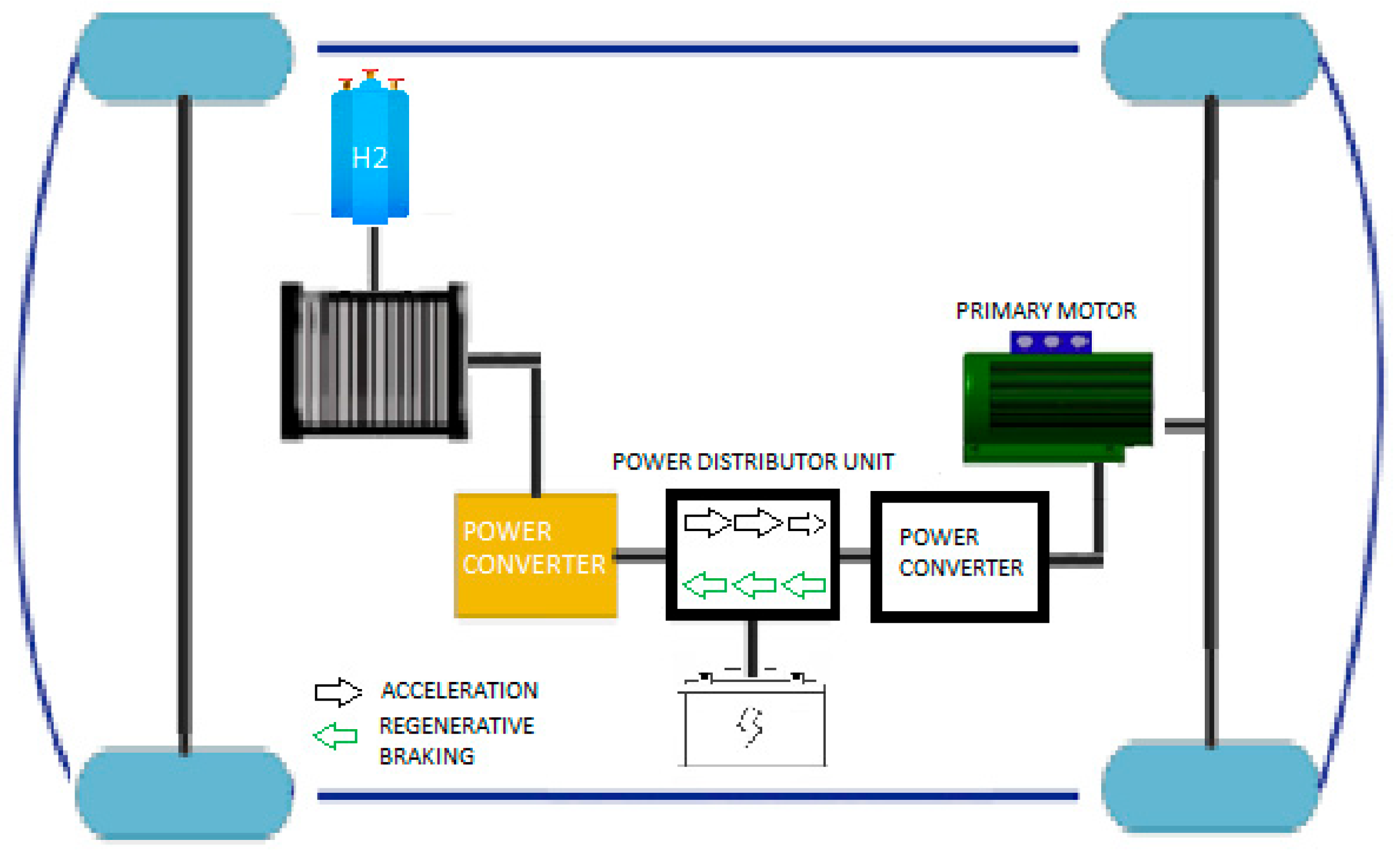
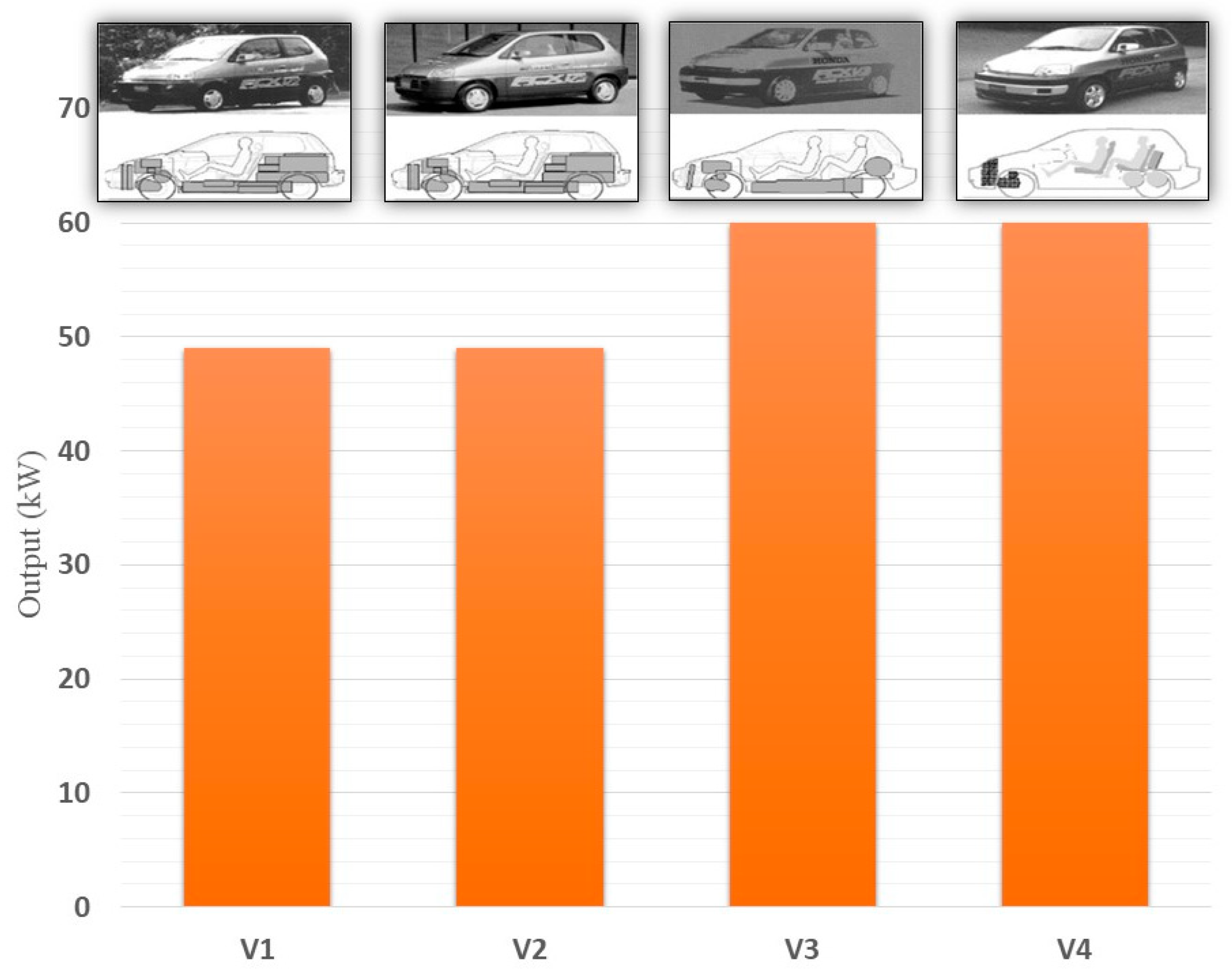
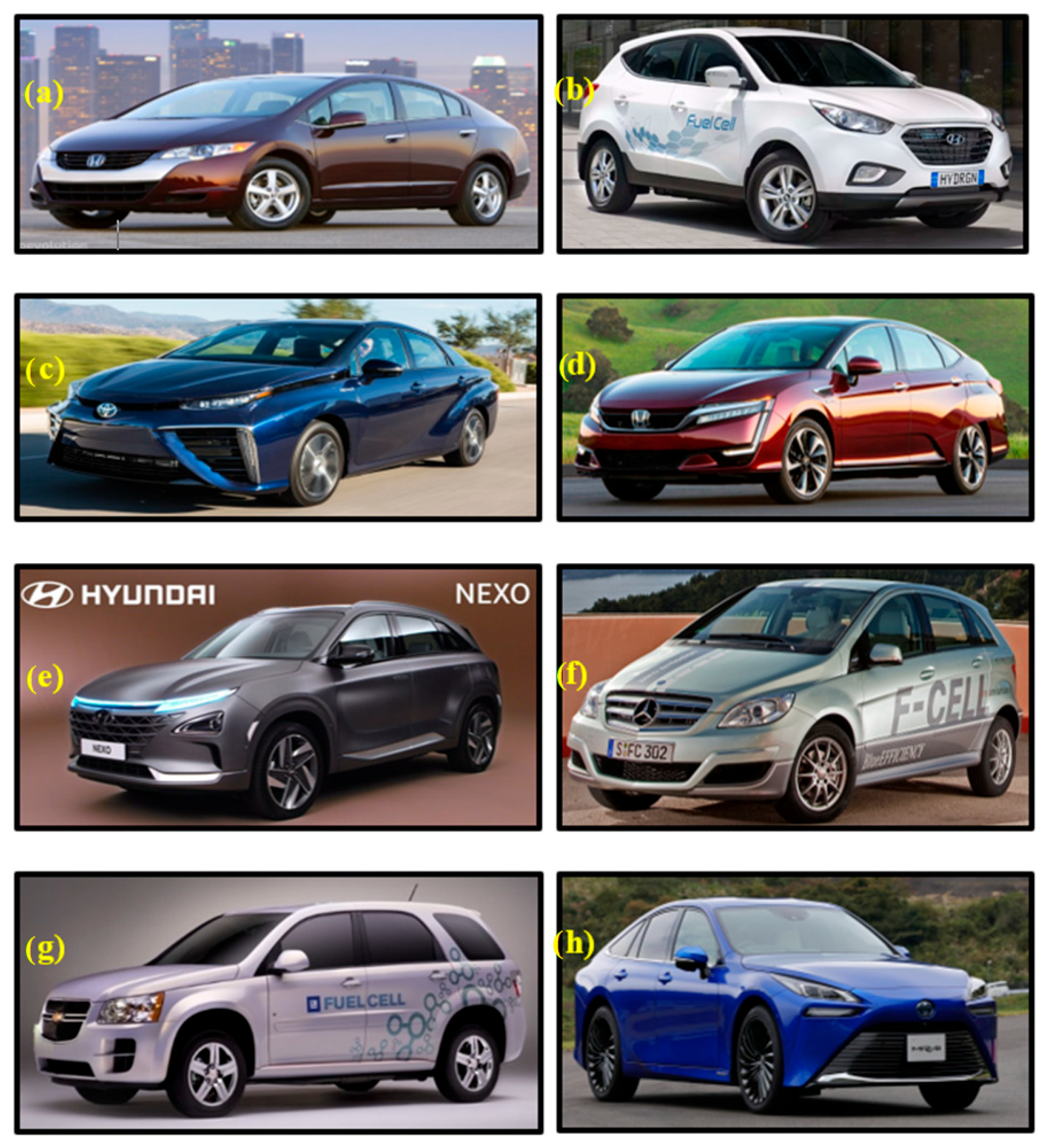
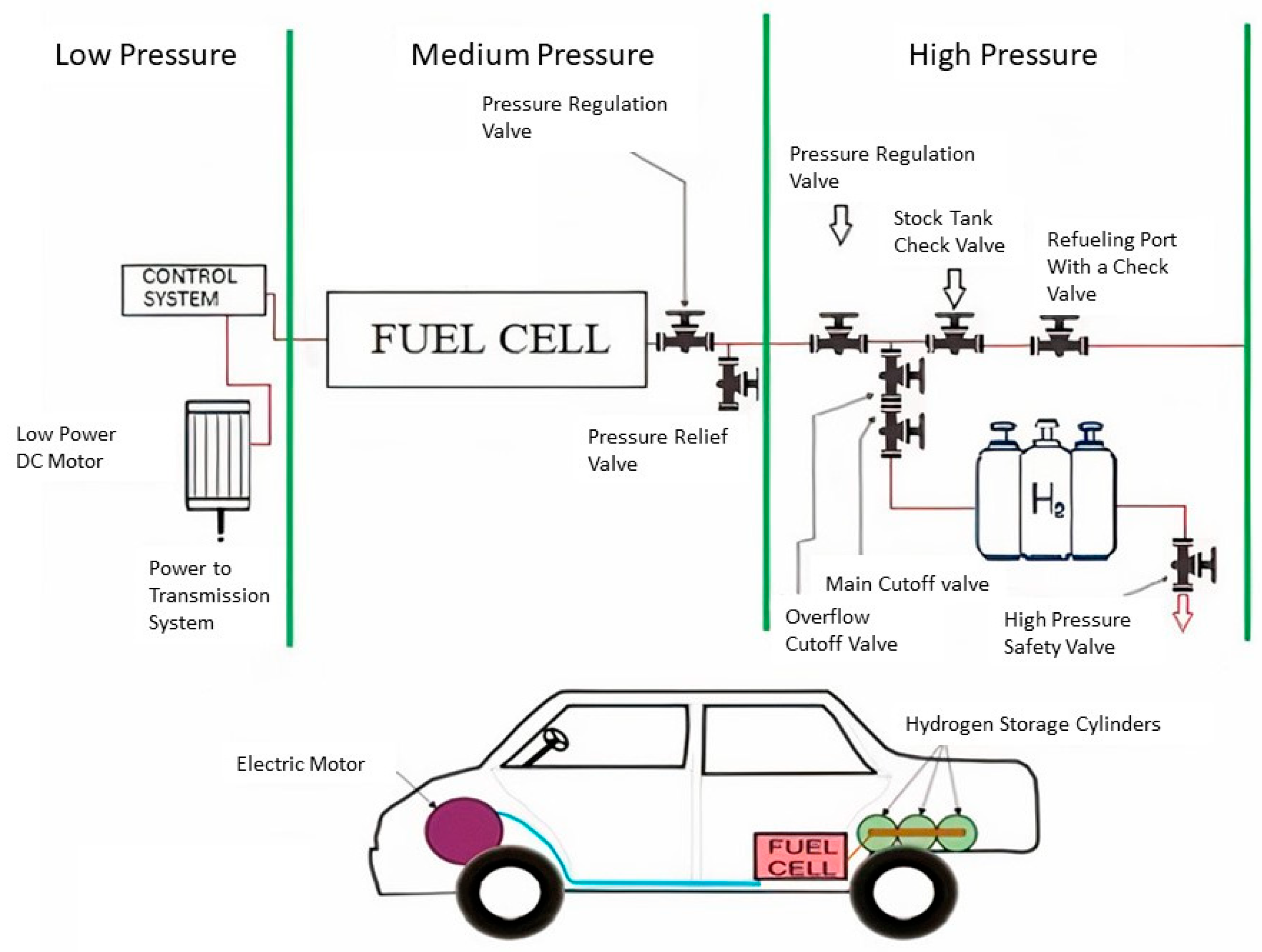
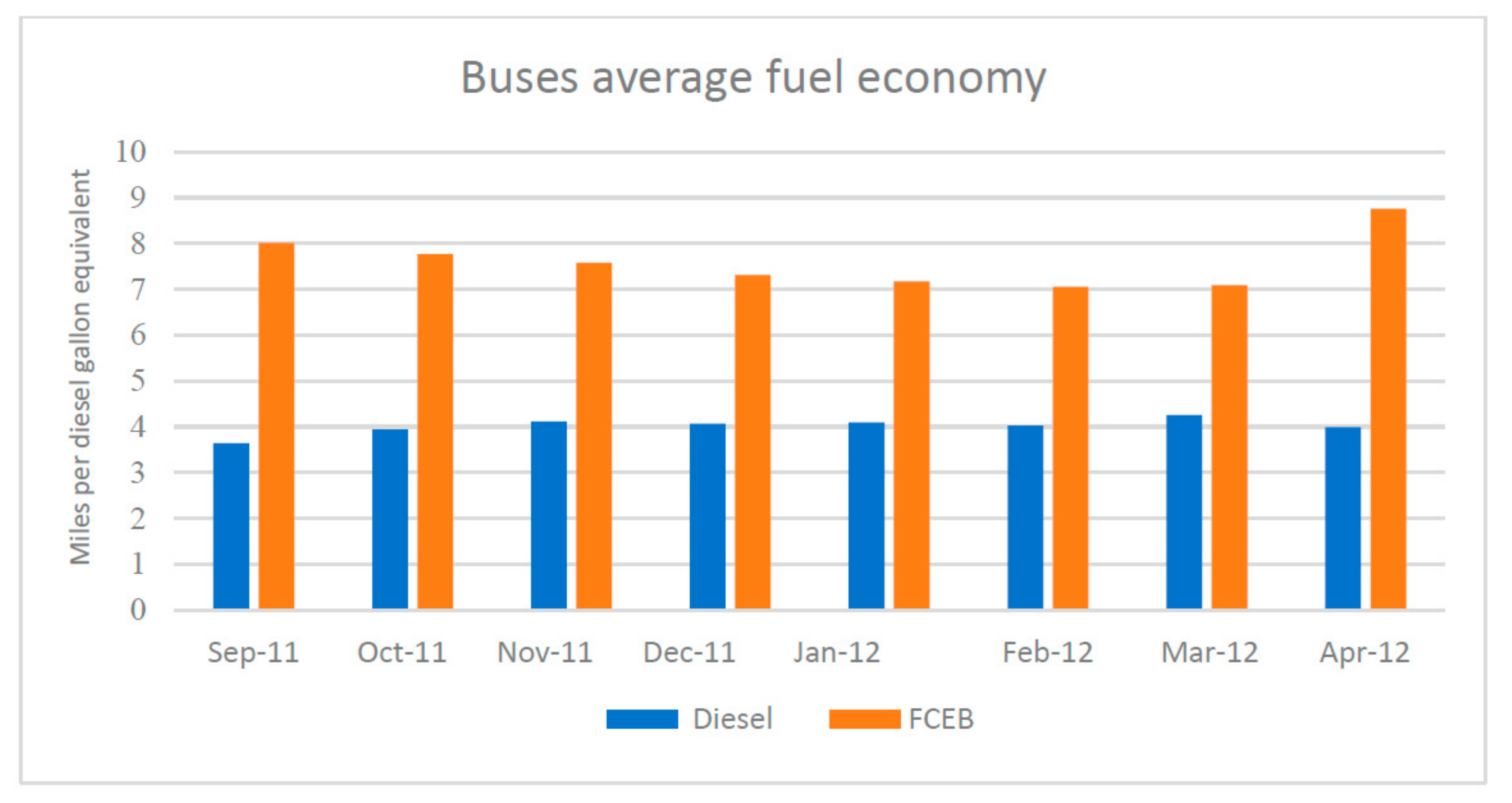
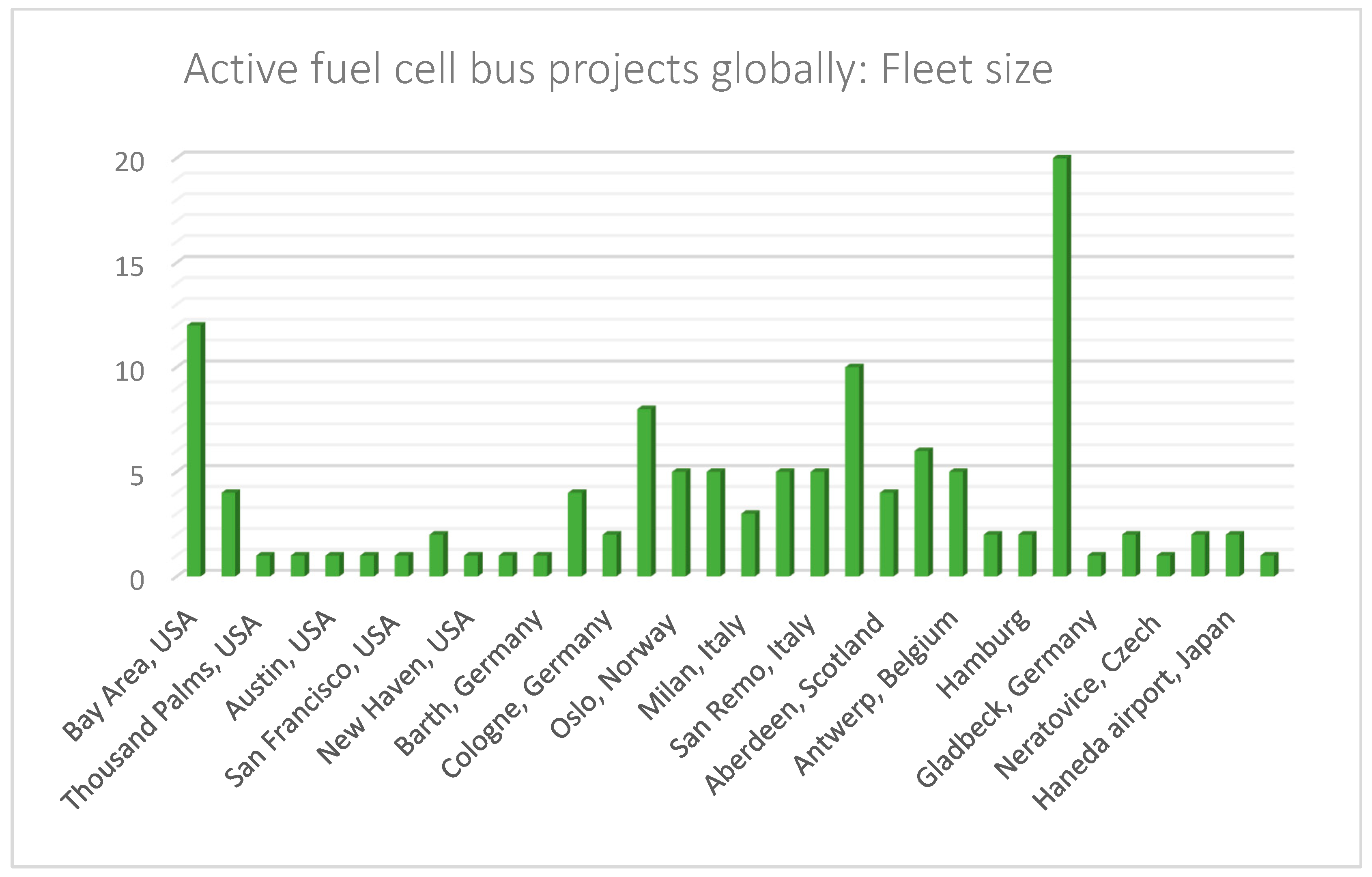

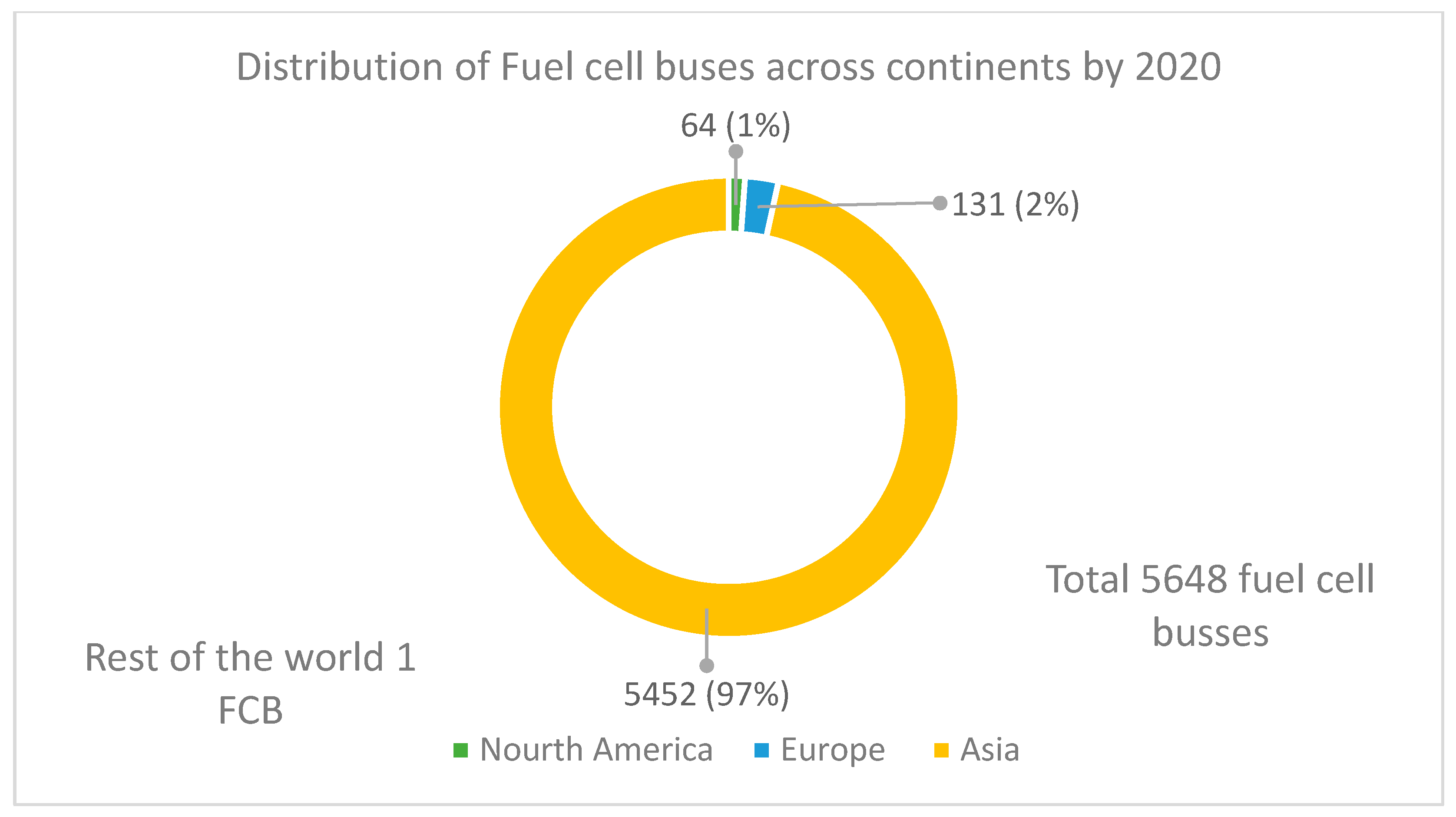

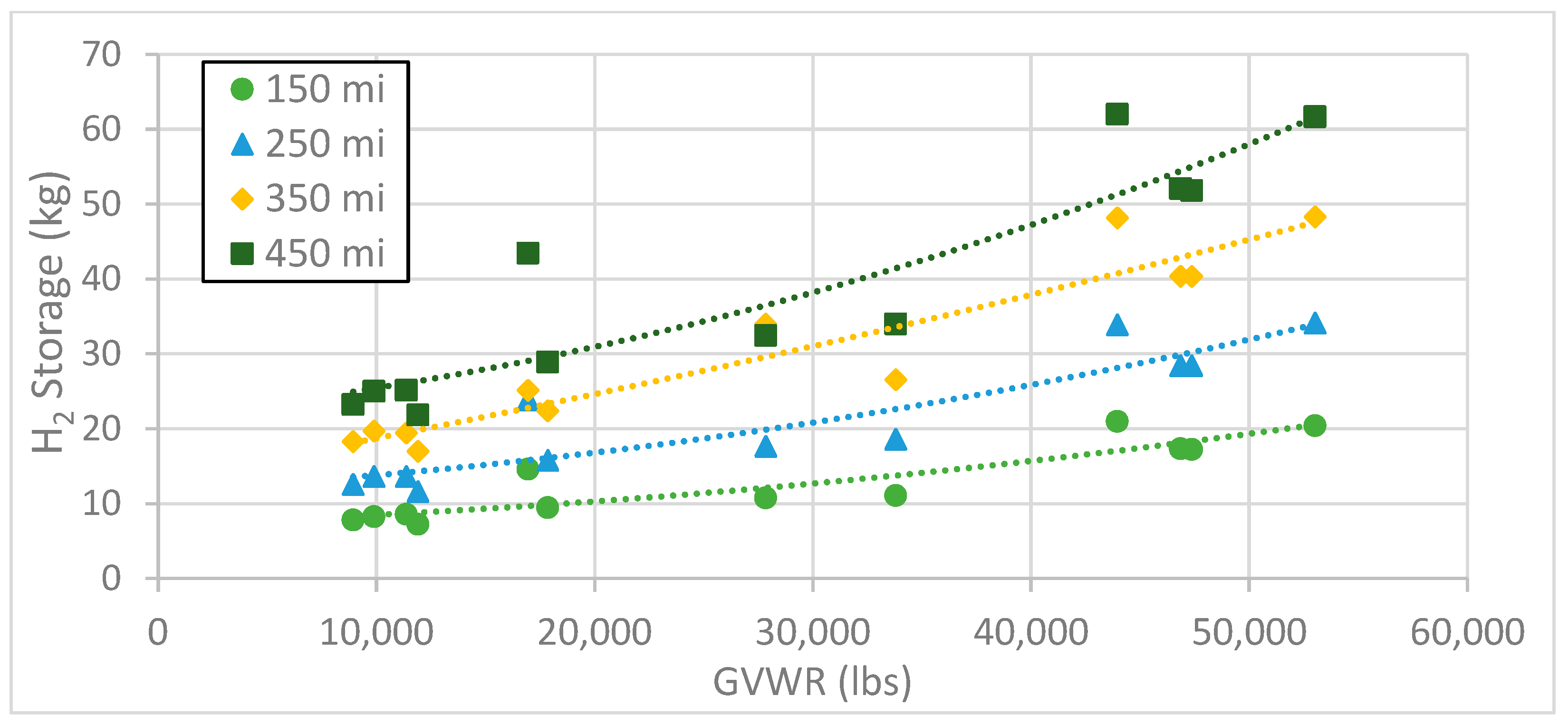
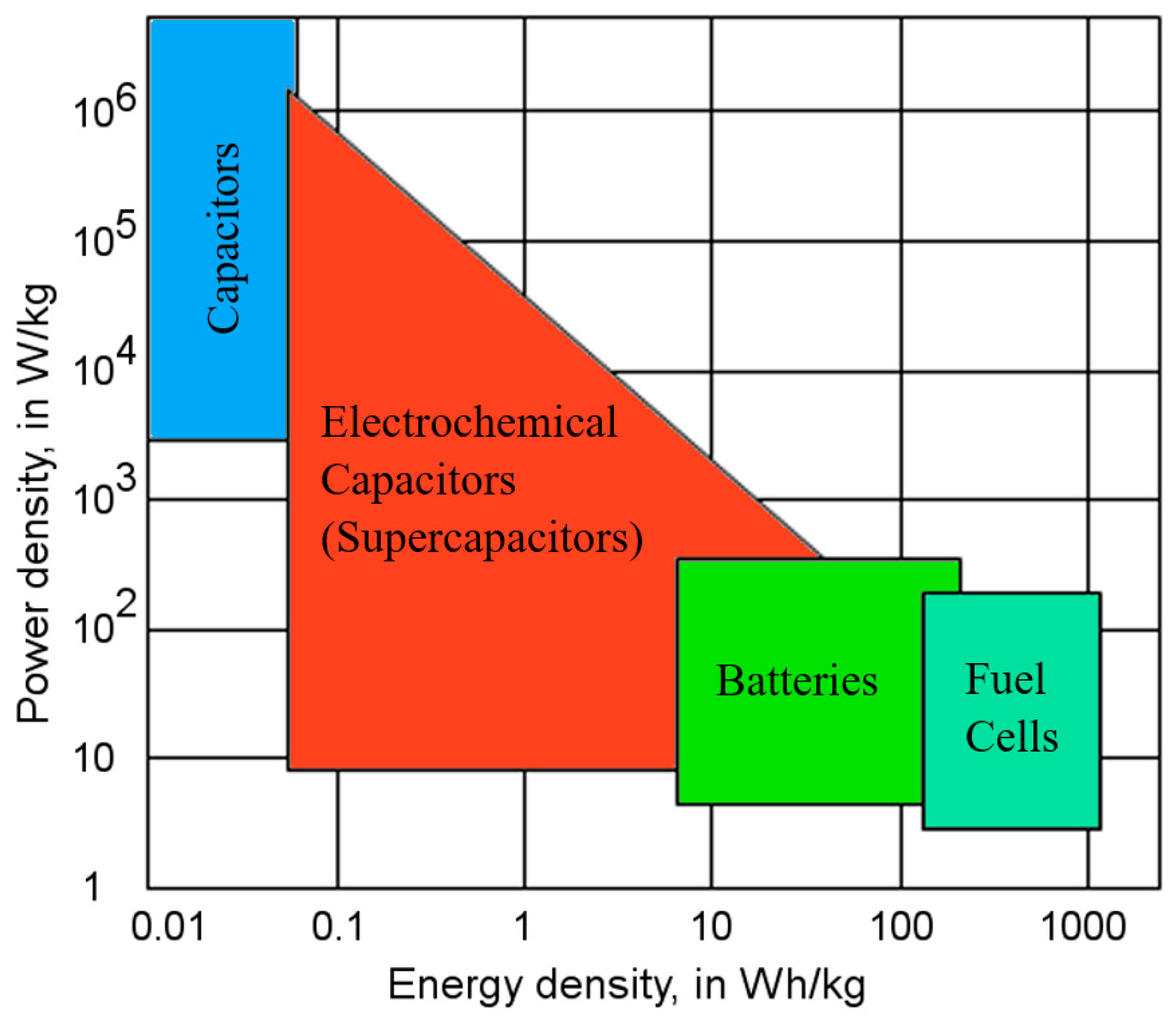
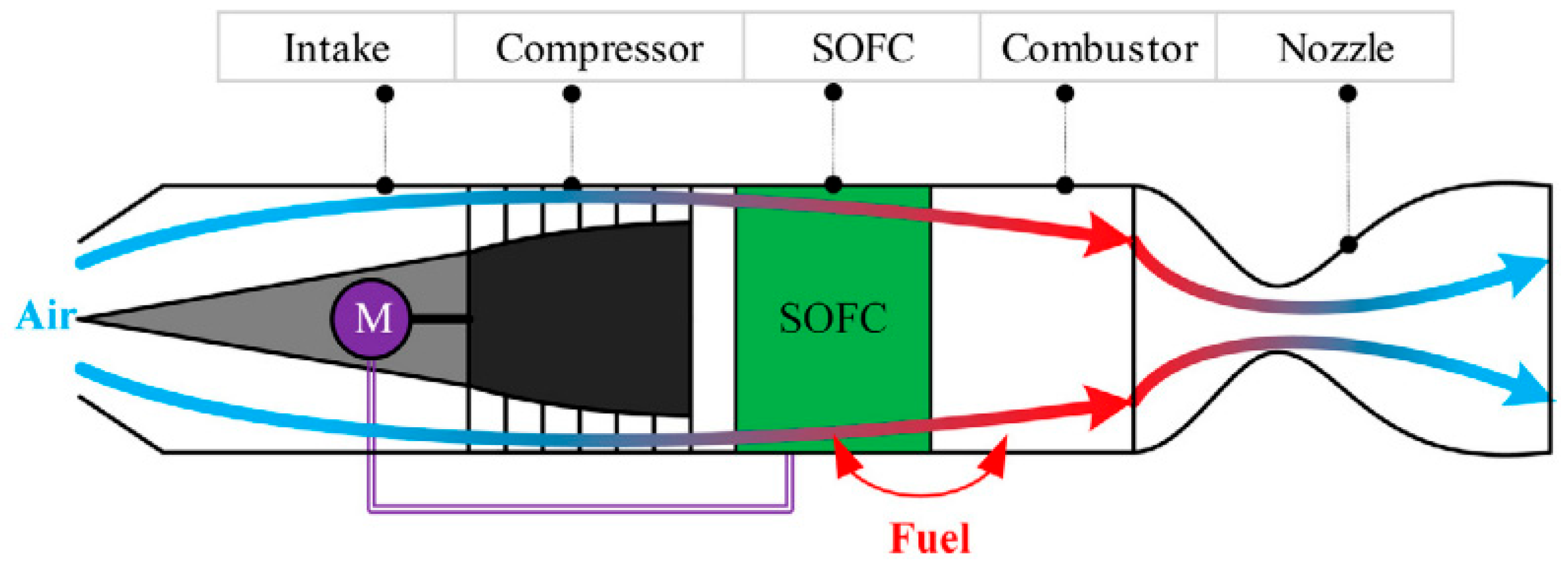
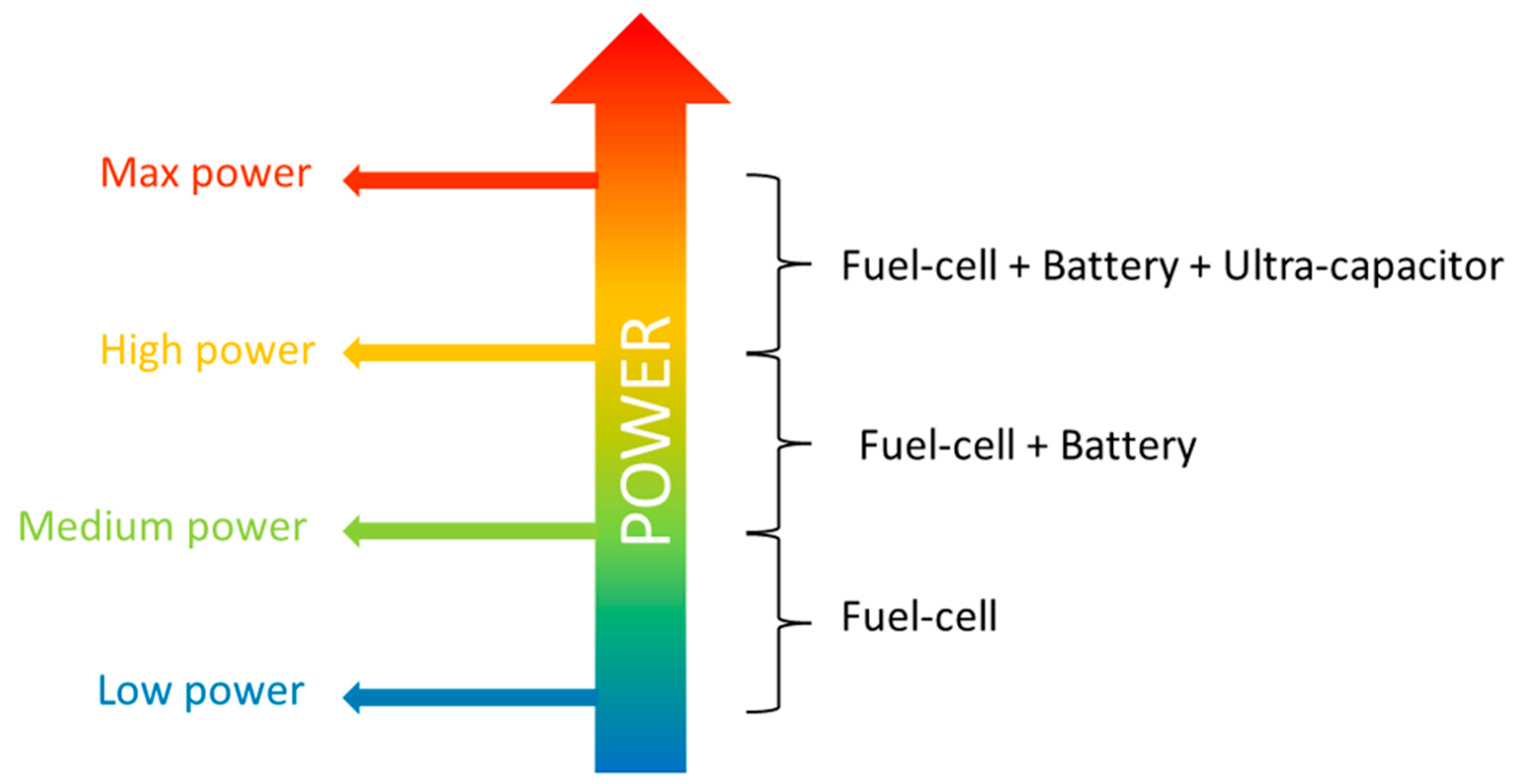
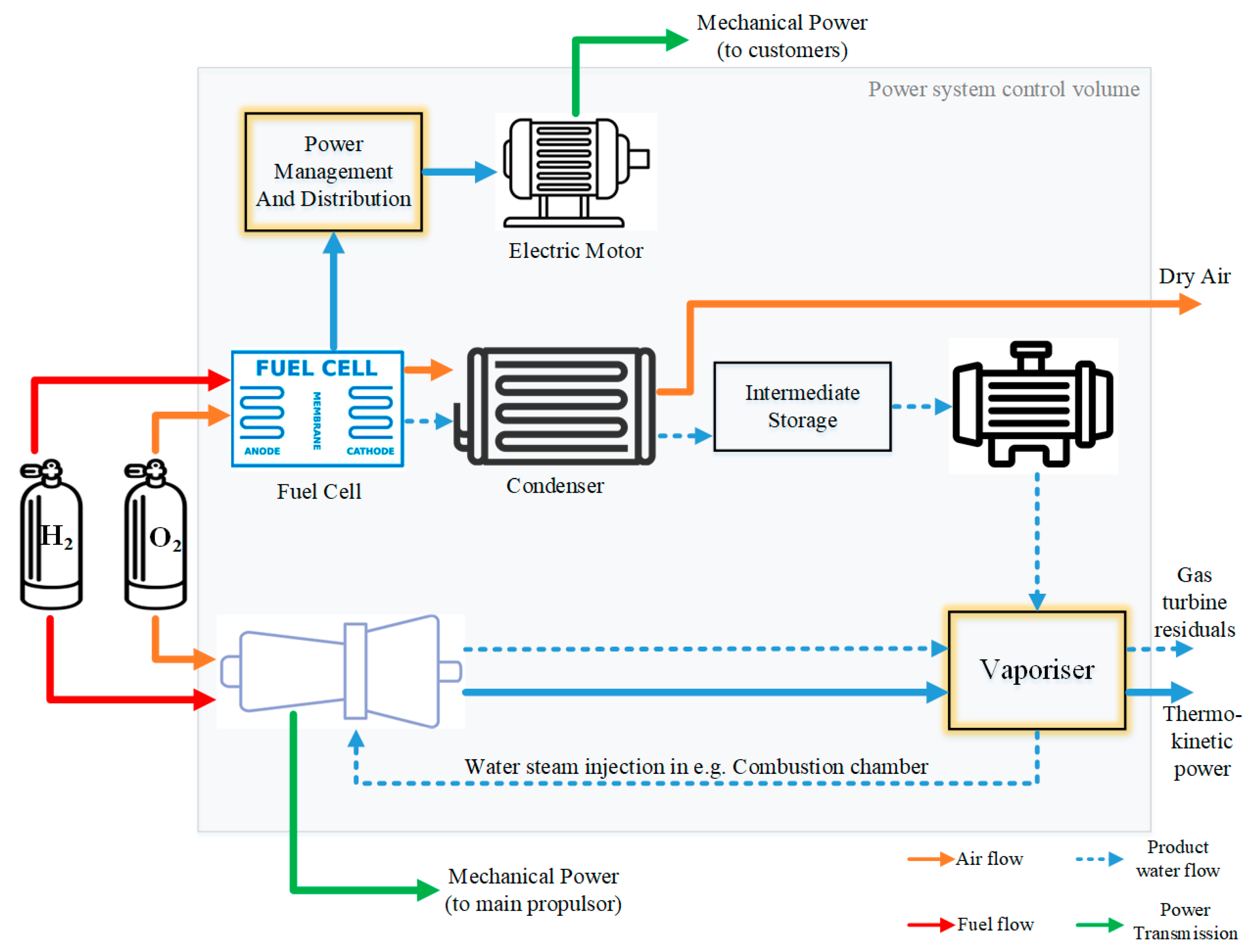
| Production Year | Vehicle Model | Range (km/Miles) | Power Output (kW/hp) | Hydrogen Tank Weight (kg)/Capacity (L) | Price |
|---|---|---|---|---|---|
| 2008 | Honda FCX Clarity [36] | 450/270 | 100/134 | 4.1/171 | USD 34,995 |
| 2013 | Hyundai Tucson/ix35 Fuel Cell [37] | 415/258 | 124/- | 5.64/140 | - |
| 2014 | Toyota Mirai I [38] | 502/312 | 114/153 | 5/122 | USD 57,500 |
| 2016 | Honda Clarity Fuel Cell—FCEV | 740/460 | 105/- | NA | |
| 2018 | Hyundai Nexo [37] | 609/378 | 135/- | 6.3/156 | USD 59,435 |
| 2010 | Mercedes Benz B-Class F-CELL [30] | 400/250 | 100/136 | 3.7/- | - |
| 2007 | Chevrolet Equinox Fuel Cell [30] | 320/200 | 94/126 | 4.2/- | - |
| 2020 | Toyota Mirai II [39] | 650/404 | 128/182 | NA | USD 49,500 |
| Configuration | Three Coaches and Two Locomotives |
|---|---|
| Size | 35.19 m × 2.65 m × 3.58 m |
| Mass | 55 tons |
| Max Passenger Capacity | 360 people |
| Max Speed | 70 km/h |
| Max Range | 125 km |
| Daily Operation | 13 h |
| Refueling Events | 2–3 times/day |
| Refueling Time | 15 min |
| Hydrogen Consumption | 25–30 kg/100 km |
| Class | 8 | 8 | 8 | 8 | 7 | 6 | 5 | 4 | 3 | Total | ||
|---|---|---|---|---|---|---|---|---|---|---|---|---|
| Weight (lbs. 103) | 60 + | 50–60 | 40–50 | 33–40 | 26–33 | 19.5–26 | 16–19.5 | 14–16 | 10–14 | |||
| Vans | Step |  | 2 | 1 | 1 | 2 | 5 | 127 | 101 | 98 | 234 | 572 |
| Enclosed |  | 4 | 4 | 14 | 18 | 87 | 294 | 178 | 80 | 256 | 933 | |
| Insulated |  | 2 | 3 | 4 | 6 | 40 | 60 | 23 | 7 | 21 | 167 | |
| Open top |  | 6 | 22 | 69 | 38 | 78 | 89 | 19 | 12 | 11 | 345 | |
| Other | 1 | 1 | 2 | 1 | 4 | 20 | 7 | 1 | 43 | 90 | ||
| Work Vehicles | Flatbed |  | 33 | 41 | 81 | 100 | 203 | 475 | 157 | 185 | 341 | 1617 |
| Dump |  | 203 | 160 | 187 | 101 | 181 | 315 | 80 | 114 | 204 | 1546 | |
| Concrete |  | 122 | 49 | 17 | 2 | 0 | 0 | 0 | 2 | 0 | 193 | |
| Tow |  | 2 | 4 | 7 | 11 | 16 | 78 | 31 | 36 | 65 | 249 | |
| Utility |  | 2 | 7 | 11 | 31 | 73 | 106 | 70 | 46 | 117 | 465 | |
| Garbage |  | 32 | 73 | 49 | 26 | 20 | 14 | 6 | 2 | 5 | 229 | |
| Freight | Tank |  | 19 | 28 | 51 | 41 | 130 | 96 | 14 | 13 | 13 | 405 |
| Beverage |  | 0 | 0 | 2 | 8 | 46 | 32 | 5 | 3 | 4 | 100 | |
| Tractor |  | 2670 | 314 | 279 | 131 | 64 | 31 | 0 | 0 | 0 | 3489 | |
| Other | 29 | 21 | 24 | 15 | 40 | 104 | 49 | 69 | 151 | 502 | ||
| Manufacturer | Range (km) | Max Gross Weight | Type of Truck | Fuel Cell Capacity | H2 Storage | Operation Status | Number of Trucks |
|---|---|---|---|---|---|---|---|
| VDL | 400 | 27 tons | Truck trailer | 88 kw | 30 kg @ 350 bar | In operation since 2020 | 1 |
| Scania/Asko | 400–500 | 27 tons | Truck trailer | 90 kw | 33 kg @ 350 bar | In operation since 2020 | 4 |
| E-trucks Europe | 400 | 26 tons | Refuse truck | 40 kw | - | - | 1 |
| SYMBIO: Renault Maxity H2 | 200 | 4.5 tons | 20 kw | Two tanks with 75 L, each one can store 4 kg of hydrogen with 350 bar | In operation | 1 | |
| ESORO | 375–400 | 34 tons combined with trailer | Heavy duty truck | 100 kw | 31 kg @ 350 bar | Started 2017. Not operational anymore | 1 |
| Nikola Motors | 805–1200 | 36 tons | Class 8—sleeper cab semi-truck | - | - | Concept—expected operation in 2022–2023 | 1 |
| LOOP Energy | - | - | Yard truck (off-road heavy duty) | 56 kw | - | In operation | 1 |
| DONGFENG | 330 | 7.5 tons | Box van truck | 30 kw | - | In operation since 2018 | 500 |
| SCANIA/Renova | - | - | Refuse truck | - | - | Concept | 1 |
| Kenworth | 320 | 36 tons | Class 8—truck trailer | 85 kw | - | In operation | 1 |
| UPS | 200 | 12 tons | Class 6—Delivery truck | 31 kw | 2 × 5 kg, high-pressure tanks | In operation | 17 |
| PLUGPOWER | 430 | - | Off-road truck | 20 kw | - | In operation | 15 |
| TOYOTA/HINO | 600 | 25 tons | Class 8—heavy duty | - | Developing a new large-capacity, high-pressure (70 MPa) hydrogen tank | Concept | - |
| MITSUBISHI FUSO | 270–300 | 7.5 tons | Rigid truck—light duty | 75 kw | 5–10 kg @ 700 bar | In operation | 150 |
| Type of the AV | Definition | Number of Passengers | Conventional Propulsion Type |
|---|---|---|---|
| UAV | A drone, also referred to as an unmanned aerial vehicle (UAV), is an aircraft operated remotely. | 0 | Battery Reciprocating engine |
| Sport Aircraft [73] | It is an aircraft other than a helicopter or powered lift with a maximum gross weight of 650 kg (300 lbs) unpressurized cabin. | Max 2 | Single reciprocating engine |
| Commuter Aircraft [74] | A commuter aircraft is primarily used by businesspeople for short-distance travel and has a maximum take-off mass of 8620 kg. | Max 19 | Multiple jet engines |
| Transport aircraft [75] | A transport aircraft refers to an airplane with multiple engines that has a seating capacity exceeding 19 or a maximum take-off weight surpassing 8620 kg (19,000). The category includes:
Regional aircraft are typically jet and turboprop aircraft, with a seating capacity ranging from 19 to 130 seats, operating on short- to medium-haul routes. | More than 19 | Multiple jet engines Turboprop engines |
Disclaimer/Publisher’s Note: The statements, opinions and data contained in all publications are solely those of the individual author(s) and contributor(s) and not of MDPI and/or the editor(s). MDPI and/or the editor(s) disclaim responsibility for any injury to people or property resulting from any ideas, methods, instructions or products referred to in the content. |
© 2023 by the authors. Licensee MDPI, Basel, Switzerland. This article is an open access article distributed under the terms and conditions of the Creative Commons Attribution (CC BY) license (https://creativecommons.org/licenses/by/4.0/).
Share and Cite
Fakhreddine, O.; Gharbia, Y.; Derakhshandeh, J.F.; Amer, A.M. Challenges and Solutions of Hydrogen Fuel Cells in Transportation Systems: A Review and Prospects. World Electr. Veh. J. 2023, 14, 156. https://doi.org/10.3390/wevj14060156
Fakhreddine O, Gharbia Y, Derakhshandeh JF, Amer AM. Challenges and Solutions of Hydrogen Fuel Cells in Transportation Systems: A Review and Prospects. World Electric Vehicle Journal. 2023; 14(6):156. https://doi.org/10.3390/wevj14060156
Chicago/Turabian StyleFakhreddine, Omar, Yousef Gharbia, Javad Farrokhi Derakhshandeh, and A. M. Amer. 2023. "Challenges and Solutions of Hydrogen Fuel Cells in Transportation Systems: A Review and Prospects" World Electric Vehicle Journal 14, no. 6: 156. https://doi.org/10.3390/wevj14060156
APA StyleFakhreddine, O., Gharbia, Y., Derakhshandeh, J. F., & Amer, A. M. (2023). Challenges and Solutions of Hydrogen Fuel Cells in Transportation Systems: A Review and Prospects. World Electric Vehicle Journal, 14(6), 156. https://doi.org/10.3390/wevj14060156









